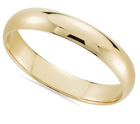 Poland has plenty of unique and curious wedding traditions and wedding superstitions. People in this country are very superstitious. But they really know a thing about celebrations! A Polish wedding can last 3-4 days, and all this time people eat, dance, drink, toast, and play games. Though, the feast is intertwined with old traditional rituals, which makes the whole wedding party more cheerful, meaningful, and important.
Poland has plenty of unique and curious wedding traditions and wedding superstitions. People in this country are very superstitious. But they really know a thing about celebrations! A Polish wedding can last 3-4 days, and all this time people eat, dance, drink, toast, and play games. Though, the feast is intertwined with old traditional rituals, which makes the whole wedding party more cheerful, meaningful, and important.
Pre-wedding
The distinctive traditions that are particular to the Polish people start before the actual ceremony takes place and it all begins with the engagement ceremony. This is, usually, just a small get-together, held at the house of the parents of either the bride or groom and provides an opportunity for the future in-laws to meet, usually, for the first time.
Next – invitations are sent out. With the groomsmen and bridesmaids getting the first wave of invites, followed by the godparents of the bride and groom and, finally, everyone else. In some of the more traditional areas of Poland, everyone in the village receives an invitation to the wedding, and if someone could not attend, they must inform bride and groom and, usually, a gift is sent anyway.
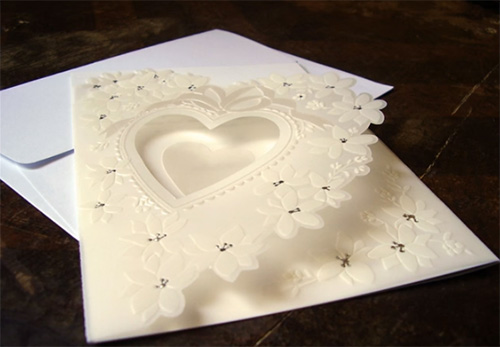
If you get invited to a Polish wedding, make sure to read your invitation carefully, because an invite to the ceremony doesn't necessarily include an invite to the party afterwards.
Finally, bachelor and bachelorette parties happen – sometimes, the night before the wedding; other times, a week or two prior. A Polish bachelor party may include just the groom and his friends going out for a few drinks, playing pool or darts, and generally socializing. A typical bachelorette party is similar and includes the bride-to-be and her friends either going out for a meal and drinks or staying at home to listen to music, play games, and gossip.
Pre-wedding blessing
Before heading to the church to begin the actual ceremony, the wedding guests gather at the home of the bride to send a couple off to the church with a blessing and symbolic farewell. It begins with the bride and groom kneeling on cushions or kneelers and holding hands. Then, a candle is lit, a crucifix is handed to the couple to hold, and the bride's mother gives her blessing, then sparkles the couple with holy water. The bride’s father does the same, then other family members, including the groom's parent, the godparents, the grandparents, etc. will give blessings. When everyone has said their part, the couple hugs and kisses their parents, and they're finally ready to head to the church.
The ceremony
It is, perhaps, not a surprise that many Polish wedding ceremonies are still held in churches. In a country where so many people have at least some ties to the Catholic Church, this remains an important part of many couples’ wedding plans.
Though fashions have certainly changed in recent years, guests might want to consider standards of modesty when in church. Longer hemlines and covered shoulders were once obligatory and should be kept in mind for more conservative affairs.
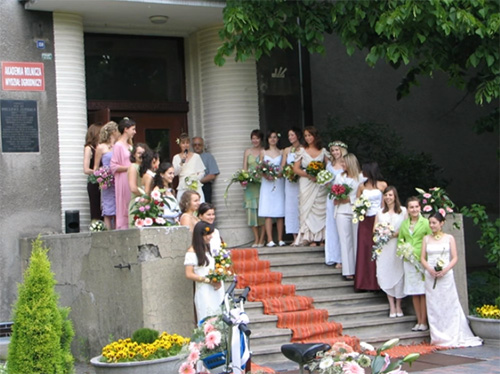
The Catholic ceremony itself is similar to Catholic rites anywhere, though those who understand the language might be surprised by the frequency of rather traditional vows. Wives often pledge service and obedience to their future husbands, though, of course, this might well reflect an observance of tradition, rather than an actual picture of the future relationship.
Those accustomed to large wedding parties will notice that many Polish couples choose to restrict the number of guests. The pair are typically joined only by their witnesses – normally family members or very close friends. Two selected witnesses accompany the bride and groom at both civil and church ceremonies.
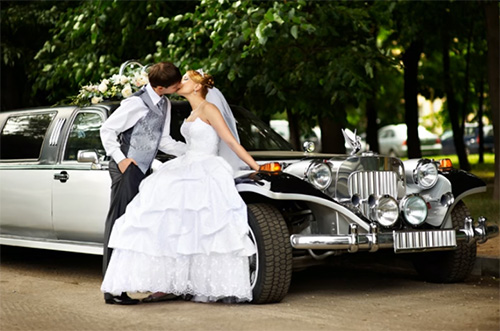
Recent trends have seen bridal parties grow, though if you see a couple with only two attendants, it's not for lack of friends but rather in adherence to customs.
Wedding superstitions
A full Catholic ceremony can be long. While you're listening, take a second to see the bride and groom have observed a number of all superstitions.
When she's walking down the aisle, it’s crucial the bride not trip over her veil. Since it also is critical that she not look back to make sure it's properly positioned, responsibility for minding the veil falls on the bride's attendant.
Next, check out the bride’s shoes. Tradition has it that they mustn't be open-toed – future wealth and fortune would fly right through the open toes.
The wrong shoe is not the only accessory that can doom the marriage. Custom dictates that brides never wear real pearls, as they will bring a lifetime of misery.
If you see the bride suddenly move a patch of her wedding dress to cover the top of her groom’s shoe, she might be following the old belief that this will give her a position of dominance in the relationship.
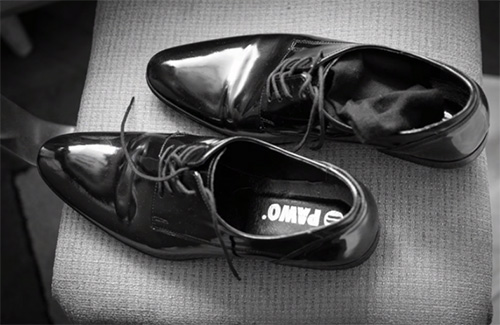
Those worried about the future of the couple also should keep an eye on any candles, lit on the altar. Tradition says, if one goes out during the ceremony, either the bride or the groom will die young.
Also, a month when the wedding is held is important in Poland. The name of the month should contain the letter “R”. In Polish, that includes March, June, August, September, October, and December. It’s thought that these months will bring good luck to marriage and does the most popular times to plan a wedding.
Having made it through the ceremony, hopefully without inadvertently cursing themselves to an unhappy future, the newlywed couple will exit the church as husband and wife.
This moment is often accompanied by the throwing of rice. You likely will find that guests in Poland shower the newlyweds with coins. Some Polish coins are quite small, thankfully. This is an adaptation of the traditional custom of throwing grain at the couple to ensure a prosperous and productive future.
The reception begins
Now that the ceremony is over, it's time for the party to begin. Many Polish wedding receptions still open with the traditional presentation of bread and salt. Up when the newlyweds arrive at the reception, their parents present them with these essentials. The bread is specially prepared and often decorated with the names of the couple. This gift of bread and salt is symbolic – bread is offered so that the couple may never know hunger, while salt reminds them of life's difficulties and the importance of learning to cope.
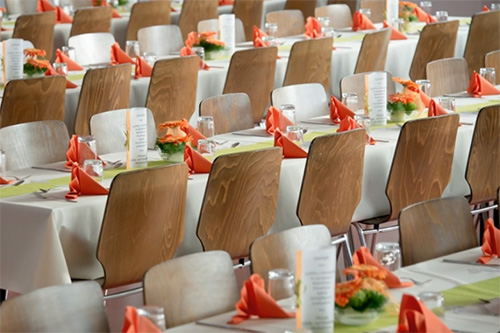
Following the bread and salt, the couple traditionally has their first toast. Customarily, the father of the bride or groom presents the couple with two glasses – one of vodka, one of water. They are offered first to the bride who must make her selection without knowing which is which. Tradition says that whoever ends up with the glass of vodka will be the dominant partner in the relationship. After the drink, the couple throw their glasses – if they break, it's a sign of good luck.
Around this time, you might notice the guests have begun to hand over envelopes of money to the bride and groom. While some couples have begun to register for gifts, giving cash is still more common. Even if handing over an envelope with a stack of bills feels a bit strange, take comfort knowing it certainly will be appreciated.
Food and drinks
With these traditional ceremonies out-of-the-way, guests can look forward to the beginning of a very long, very filling evening. Current wedding guides advise that for a standard wedding, lasting about 12 hours, they are typically served 4-5 hot entries, along with appetizers, pastries, cake, and fruit. So if you finish your first meal and think it wasn't fulfilling, just wait – there is more to come.
The same wedding guide suggests a hot meal be served approximately every 3 hours. Menus will vary, based on the taste of specific couples, but guests can expect a spread of cold starters to include cheeses, meats, vegetables, and herring.
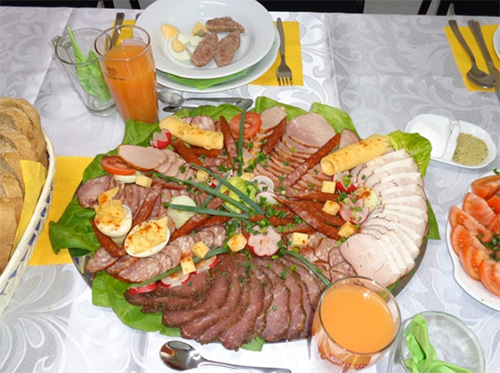
There probably will be a soup or two.
Hot entries might include grilled meats, roast chicken, smoked or baked fish, pork loin, tripe, hearty stews, potatoes, and bread.
Guests will also be treated to pastries, fruit, and cake.
The Polish presentation of wedding cake is quite similar to that in other parts of the world, with the bride and groom cutting the first pieces and feeding one another.
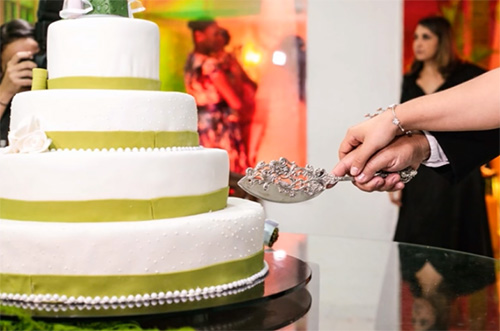
All that food will be washed down with a seemingly endless supply of drink. The most popular beverage, as one might suspect, is vodka, and it flows freely through the night. The gathering may spontaneously raise their glasses and start chanting “Goshko! Goshko!”, meaning “Bitter! Bitter!”, in order to demand a kiss from the groom and bride – in other words, to ask for some sugar.
“Oczepiny”
Where many weddings would be wounding down as midnight approaches, a Polish wedding is just approaching one of its most traditional moments – the removal of the bride's veil. This ceremony, called “Oczepiny”, traditionally represents that transitional moment of the bride, as she moves from her single youth toward her married future. The midnight hour was significant as this is a time of transition.
The details of the ceremony have changed significantly over the years, but it remains a memorable moment in many contemporary Polish weddings.
Traditionally, the oczepiny ceremony began with the unbraiding and cutting of the young bride's hair. Long braids were symbolic of girlhood freedom and, as a newly married woman, the bride's hair was unbraided to reflect her new marital status.
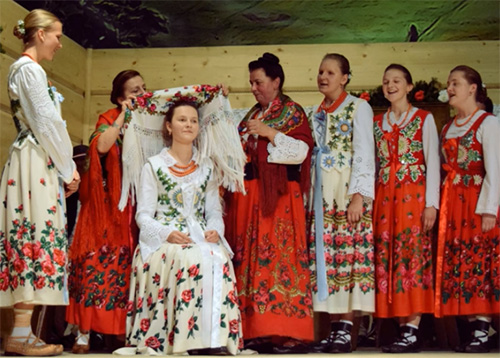
With the unbraiding of her hair, also came the removal of the bride's wedding veil. The veil was exchanged for a special wedding cap – customarily, a gift from a bride’s godmother. It is said that a bride has traditionally refused the cap 3 times, as it represented the loss of independence and youth. Once accepted, the cap became a special symbol of the marriage and was only worn on very special religious occasions.
These days, not surprisingly, brides don't often mark this occasion with a change in their hairstyle. The oczepiny has instead become a time for fun and games. The bride removes her veil and tosses it into gathering crowd of single women. The groom also gets in on the fun, removing and throwing his tie to the assembled male guests. It is said that those who catch those garments, be the next to marry, though not necessarily each other.
After the removal of veil and tie, the bride and groom might choose to play a number of games. The character of these games can vary. Some couples play a little trivia game about one another. Other options involve guests in silly competitions or the scavenger hunts. This traditional ritual has become a playful moment in contemporary Polish weddings.
A second day – “poprawiny”
After the oczepiny, wedding receptions continue late into the night. Eating, dancing, drinking, and toasting often last into the morning. As one can imagine, this 12-hour feast can get rather spirited and can be quite exhausting.
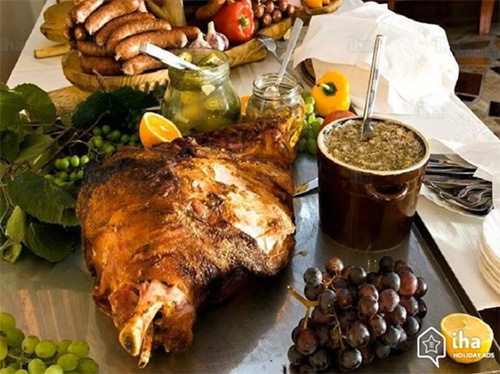
Lasting through the night is certainly an accomplishment, but it does not mean that your wedding experience is complete. Polish weddings can include a second day of partying and historically, some wedding parties lasted 3 or 4 days.
This follow-up reception called “poprawiny” typically consists of more eating, drinking, and good cheer.
(c)
